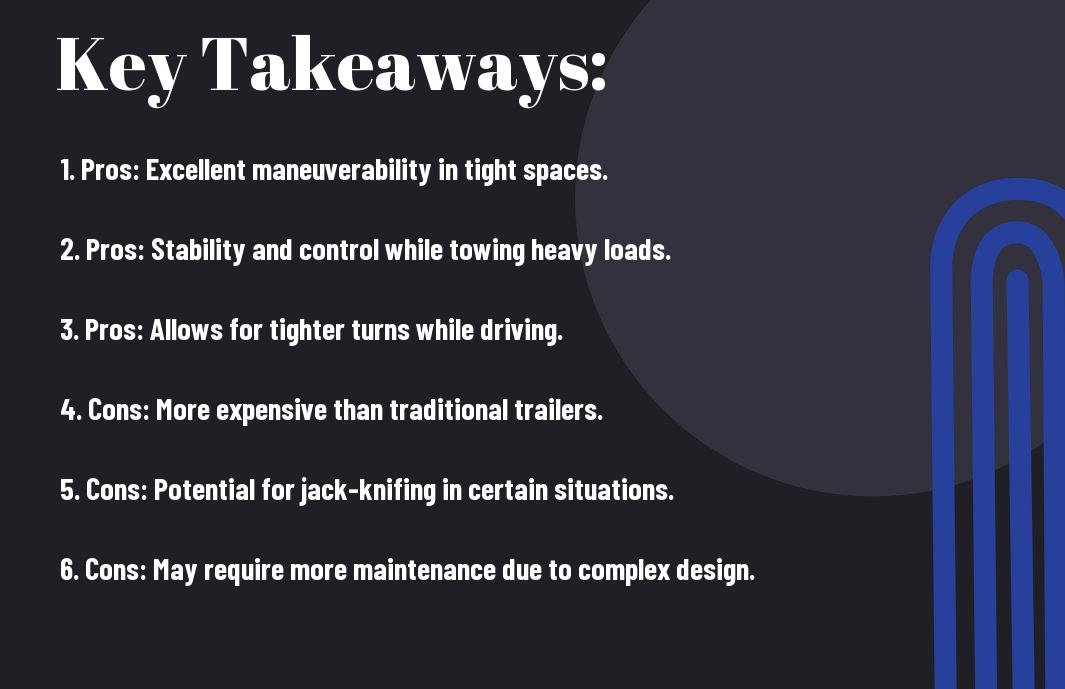If you’re considering purchasing a gooseneck trailer, it’s important to weigh the advantages and disadvantages of this type of trailer. Gooseneck trailers offer several benefits, such as increased stability and towing capacity, but they also come with their own set of drawbacks. In this blog post, we’ll explore the pros and cons of gooseneck trailers so you can make an informed decision about whether this type of trailer is right for you. Whether you’re hauling livestock, equipment, or other heavy loads, understanding the advantages and disadvantages of a gooseneck trailer is crucial for ensuring a safe and efficient hauling experience.
Key Takeaways:
- Pros:
- Greater maneuverability: Gooseneck trailers offer improved maneuverability and easier handling compared to traditional bumper pull trailers, making them suitable for tight spaces and towing on winding roads.
- Increased stability: The gooseneck hitch design provides better stability and control, reducing the risk of swaying and improving overall towing safety.
- Higher weight capacity: Gooseneck trailers can typically carry heavier loads compared to bumper pull trailers, making them ideal for hauling heavy equipment and livestock.
- Better weight distribution: The forward placement of the gooseneck hitch allows for more balanced weight distribution, resulting in better control and braking performance.
- Improved turning radius: Gooseneck trailers allow for tighter turns and sharper maneuvers, making them suitable for navigating in crowded areas and around obstacles.
- Cons:
- Higher cost: Gooseneck trailers tend to be more expensive than bumper pull trailers, both in terms of initial purchase price and installation of a gooseneck hitch in the towing vehicle.
- Specialized hitch requirement: Towing a gooseneck trailer requires a specialized hitch installed in the bed of the towing vehicle, which may limit the versatility of the vehicle for other purposes.
- Reduced bed space: The gooseneck hitch takes up valuable bed space in the towing vehicle, limiting the available cargo area for other gear and equipment.
- Greater weight on towing vehicle: The design of gooseneck trailers places more weight directly over the rear axle of the towing vehicle, potentially affecting fuel efficiency and handling.

Advantages of Gooseneck Trailers
Obviously, when considering whether to invest in a gooseneck trailer, it’s important to weigh the pros and cons. There are several advantages to using a gooseneck trailer that make them a popular choice for hauling heavy loads. Let’s take a look at some of the key benefits that gooseneck trailers offer.
Increased Stability and Handling
One of the major advantages of using a gooseneck trailer is the increased stability and handling it provides. By attaching to the bed of the towing vehicle, rather than the bumper, a gooseneck trailer creates a more stable connection. This reduces swaying and bouncing, providing a smoother and safer ride. Additionally, the positioning of the hitch allows for better weight distribution, which improves overall handling and control while towing. This means your cargo is less likely to shift during transport, reducing the risk of accidents or damage to your payload.
Enhanced Load Capacity
Another benefit of gooseneck trailers is their enhanced load capacity. The design of a gooseneck hitch allows for a higher weight rating compared to a traditional bumper pull trailer. This makes gooseneck trailers ideal for hauling heavy loads, such as livestock, construction materials, or large equipment. The increased load capacity means you can transport more cargo in fewer trips, saving you time and money in the long run.
Tighter Turning Radius
With a gooseneck trailer, you can enjoy a tighter turning radius compared to other types of trailers. This can be especially advantageous when navigating through tight spaces or maneuvering in confined areas, such as on a job site or in a crowded parking lot. The improved maneuverability can make towing a gooseneck trailer much easier and less stressful, ensuring that you can get to your destination without any unnecessary hassle.
Additional Storage Space
Gooseneck trailers often feature a dedicated storage area over the gooseneck hitch, providing valuable additional space for hauling tools, supplies, or other gear. This extra storage space can be particularly useful for those who need to transport equipment or materials along with their primary cargo. Whether you’re hauling livestock and need space for feed and supplies, or you’re carrying construction materials and require room for tools, the added storage capacity of a gooseneck trailer can be a real game-changer.
Optimal Weight Distribution
Gooseneck trailers are designed to provide optimal weight distribution, especially when towing heavy loads. The positioning of the hitch over the rear axle of the towing vehicle helps evenly distribute the weight of the trailer and its cargo. This balanced weight distribution not only improves the stability and handling of the rig but also reduces the strain on the towing vehicle. By evenly distributing the weight, you can minimize wear and tear on your vehicle, helping to extend its lifespan.
Disadvantages of Gooseneck Trailers
To fully understand whether a gooseneck trailer is right for you, it’s important to consider its disadvantages. While gooseneck trailers have numerous benefits, they also come with their own set of drawbacks that you should take into account.
Requirement of a Pickup Bed
One of the main drawbacks of gooseneck trailers is that they require a pickup truck with a specialized hitch installed in the bed. This means you won’t be able to use your regular vehicle for towing, and you’ll need to invest in a truck with the appropriate setup. This additional requirement can limit your options and may be a deciding factor for some individuals.
Steeper Initial Investment
Compared to bumper pull trailers, gooseneck trailers typically come with a steeper initial investment. Not only will you need to purchase the trailer itself, but you’ll also need to invest in a compatible truck if you don’t already have one. The higher cost upfront may be a deterrent for those on a tighter budget.
Licensing and Regulations
Another potential downside of gooseneck trailers is that they may be subject to stricter licensing and regulations compared to bumper pull trailers. Depending on your location and the size of the trailer, you may be required to obtain special permits or licenses to operate a gooseneck trailer. These additional legal requirements can add time and cost to your towing endeavors.
Maneuvering Challenges
Due to their design, gooseneck trailers can present maneuvering challenges, especially for less experienced drivers. The pivot point located further towards the front of the vehicle can make tight turns more difficult, requiring you to adapt your driving techniques. If you’re not confident in your towing abilities, this added complexity may be a concern for you.
By considering these disadvantages, you can make a well-informed decision on whether a gooseneck trailer aligns with your towing needs and capabilities. While these drawbacks may present challenges, they can often be managed with the right preparation and equipment.
Gooseneck Trailers in Use
Unlike traditional bumper-pull trailers, gooseneck trailers are widely used in a variety of applications due to their unique design and towing capabilities. Let’s take a look at some of the most common uses of gooseneck trailers.
Recreational Applications
For recreational purposes, gooseneck trailers are often used for towing large recreational vehicles such as horse trailers, RVs, and fifth-wheel campers. The added stability and weight distribution of a gooseneck trailer make them an ideal choice for transporting heavy recreational equipment, providing a smooth and safe towing experience for your next adventure.
Commercial and Industrial Uses
In the commercial and industrial sector, gooseneck trailers are commonly used for transporting heavy equipment and machinery. Their high weight carrying capacity and stability make them perfect for hauling construction materials, machinery, and other large items to and from job sites.
Agriculture and Livestock Transportation
When it comes to agriculture and livestock transportation, gooseneck trailers are an essential tool. Their maneuverability and weight distribution make them an ideal choice for hauling livestock, hay, and other agricultural products while providing a comfortable and safe ride for the animals.
Comparison with Other Trailer Types
When compared to other trailer types, gooseneck trailers offer several advantages, including increased stability and weight distribution, higher weight carrying capacity, and better turning radius. However, it’s important to note that they also have some drawbacks, such as higher initial cost and limited maneuverability in tight spaces.
Recognizing the specific needs of your towing requirements is essential in determining whether a gooseneck trailer is the right choice for you.
| Pros | Cons |
| Increased stability and weight distribution | Higher initial cost |
| Higher weight carrying capacity | Limited maneuverability in tight spaces |
| Better turning radius |
Conclusion
Conclusively, the gooseneck trailer offers several advantages such as increased stability, better maneuverability, and a higher weight capacity. However, there are also some drawbacks including the need for a specialized towing vehicle, limited accessibility to certain areas, and potential difficulty in parking and maneuvering in tight spaces. When considering whether to invest in a gooseneck trailer, it is important to weigh these pros and cons carefully and determine if the benefits outweigh the limitations for your specific hauling needs. Your decision should be based on the type and frequency of loads you will be transporting, as well as your comfort and experience with towing larger trailers. Ultimately, the gooseneck trailer can be a powerful tool for hauling heavy loads, but it may not be the best option for every situation.
FAQ
Q: What are the pros of a gooseneck trailer?
A: Gooseneck trailers offer better stability and towing capabilities compared to bumper-pull trailers. They also provide a tighter turning radius, making them easier to maneuver in tight spaces. Additionally, the design of a gooseneck trailer distributes weight more evenly, resulting in a smoother and safer towing experience.
Q: What are the cons of a gooseneck trailer?
A: One of the main drawbacks of a gooseneck trailer is the initial cost, as they are generally more expensive than bumper-pull trailers. Additionally, they require a specialized hitch installed in the bed of a truck, which may not be feasible for some vehicles. Gooseneck trailers also tend to have a higher deck height, making them less convenient for loading and unloading heavy equipment.
Q: Are gooseneck trailers suitable for long-distance towing?
A: Yes, gooseneck trailers are well-suited for long-distance towing. Their stability and weight distribution make them ideal for hauling heavy loads over extended distances. However, it’s important to ensure that your vehicle is properly equipped to handle the additional weight and towing requirements of a gooseneck trailer.
Q: Can a gooseneck trailer be used for both commercial and recreational purposes?
A: Absolutely. Gooseneck trailers are versatile and can be used for a wide range of applications, including commercial hauling, livestock transportation, and recreational activities such as horse or RV towing. Their durability and towing capabilities make them a popular choice for both professional and leisure activities.
Q: What type of vehicle is required to tow a gooseneck trailer?
A: Towing a gooseneck trailer requires a heavy-duty truck with a specialized gooseneck hitch installed in the bed. The vehicle must have the towing capacity to handle the weight of the trailer and its cargo. It’s important to consult the vehicle’s manufacturer guidelines and specifications to ensure it is suitable for towing a gooseneck trailer.
